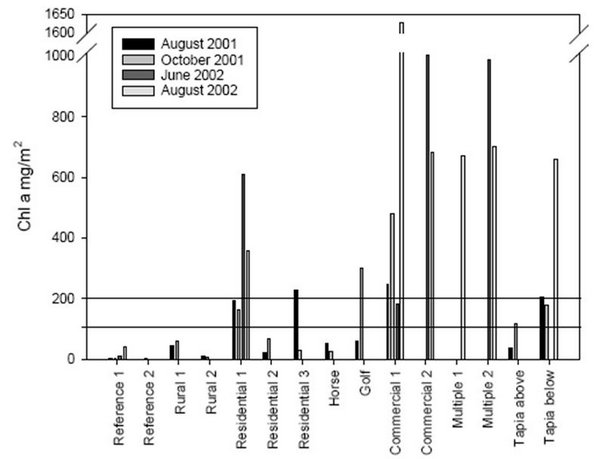 Research Areas > Nutrients > Survey of Algae and Nutrients in the Malibu Creek Watershed
Research Areas > Nutrients > Survey of Algae and Nutrients in the Malibu Creek Watershed
Project: Survey of Algae and Nutrients in the Malibu Creek Watershed
Background and Objective
Excessive algal growth can have many negative impacts on streams, including reduction in ecological function. For example, algal blooms can create extreme daily variation in dissolved oxygen levels which can be harmful or fatal to aquatic invertebrates and fish. In addition, nuisance levels of algae can hinder recreational activities such as fishing, wading, boating, and aesthetic appreciation.
Growth of algae in individual streams or reaches of streams may be limited by one or a combination of factors such as: nitrogen levels alone, nitrogen (N) and phosphorus (P) together, light availability, water velocity, or disturbance regime. The relationship between nutrients and algae in any particular stream can be complex and difficult to predict based on studies in other stream systems. Thus, the question of nutrient limitation of algal growth and biomass must be addressed on a case-by-case basis.
The objective of this project was to address two principal questions: 1) What is the biomass of different algal species present in streams in the Malibu Creek watershed? and 2) Which nutrients and nutrient levels, if any, cause increases in algal biomass?
Status
This project was conducted from 2001 to 2003.
Methods
For this project, several parameters (including algal biomass, percent cover of algae, species composition of benthic and floating algae, and nutrient levels) were measured on four occasions at stream sites with a diversity of surrounding land uses. These land uses ranged from a reference or natural state to rural, high density residential, and commercial. Sites adjacent to horse stables, a golf course and a municipal sewage treatment plant were also studied. In addition to sampling, a separate experiment took place using a nutrient diffuser to identify whether algal growth was limited by the supply of nitrogen or phosphorus.
A nutrient diffuser substratum used to determine nutrient limitation at a site.
Findings
Significant findings included:
• Algal biomass, macroalgal cover, and nutrient concentrations increased in areas with increasing human influence.
• Most of the developed sites in the Malibu Creek watershed had chlorophyll-a concentrations which exceeded suggested thresholds for acceptable levels of chlorophyll. Only the reference, rural, and horse sites had levels below these thresholds.
• Benthic (bottom-dwelling) algal biomass was positively related to nutrient concentrations and current speeds, whereas the biomass of floating (surface) algae was positively related to light and nutrient levels but negatively related to current speeds. Total algal biomass was positively correlated with nutrient concentrations and light levels.
• N limitation was found at the reference site and the site below the Tapia water treatment plant, but no algal biomass response to nutrient enrichment was observed at other developed sites, suggesting that they were not nutrient limited. Drastic reductions in N or P loading at these sites may be required to reduce nutrient concentrations to sufficiently limit algal growth.
• Based on these findings, it was recommended that management measures should be developed on a site-by-site basis to account for individual environmental conditions, types of algae, and nutrient sources.

Variation in algal biomass (as indicated by chlorophyll-a concentration) in streams with different surrounding land use types.
Partners
This project was conducted in collaboration with researchers from the University of California, Santa Barbara.
This page was last updated on: 6/30/2014